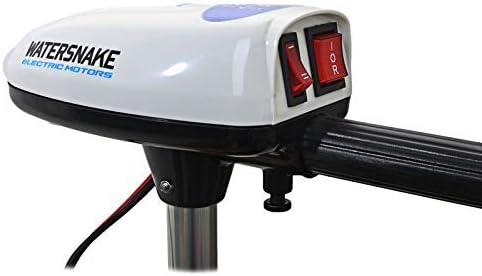Kayak fishing has evolved significantly over the years, with anglers increasingly turning to trolling motors to enhance their fishing experience. Trolling motors provide convenience, efficiency, and versatility, allowing kayakers to cover more water and stay on target. However, choosing the right trolling motor configuration can be a daunting task with various options available. In this article, we’ll compare the top kayak trolling motor configurations to help you make an informed decision.
Top Kayak Trolling Motor Configurations from each category
| Bow Mounted | AQUOS Haswing Trolling Motor |
| Bow Mount Runner Up | MotorGuide 940200090 X3 Freshwater Bow Mount Trolling Motor |
| Transom Mounted | Watersnake T24 ASP |
| Transom Motor Mount | BKC Brooklyn Kayak Company UH-TM315 Kayak Trolling Motor Mount |
1. Bow-Mounted Trolling Motor
Bow-mounted trolling motors are the most common choice for kayak anglers due to their versatility and ease of use. These motors are installed at the front (bow) of the kayak and can be controlled conveniently by foot or hand, allowing for precise maneuvering.
Top Pick
Pros:
1. **Maneuverability**: Bow-mounted motors offer excellent control and maneuverability, enabling anglers to position their kayak with precision, even in tight spaces or against the wind.
2. **Stability**: They provide added stability to the kayak, which is especially beneficial when fishing in rough waters or dealing with strong currents.
3. **Hands-Free Operation**: Some models come with foot pedals, allowing anglers to operate the motor without using their hands, thus keeping them free for casting, reeling, and other fishing tasks.
4. **Durability**: Bow-mounted motors are designed to withstand harsh marine environments, ensuring they last for many seasons.
Cons:
1. **Installation**: Setting up a bow-mounted trolling motor can be a bit more complex than other configurations, requiring careful installation and maintenance.
2. **Weight Distribution**: Adding a bow-mounted motor can affect the kayak’s weight distribution, potentially making it less balanced or front heavy.
2. Transom-Mounted Trolling Motor
Stern-mounted trolling motors are installed at the rear (stern) of the kayak. While less common than bow-mounted motors, they have their advantages and are preferred by some anglers.
Top Pick
Pros:
1. **Simplicity**: Stern-mounted motors are easier to install, making them a practical choice for anglers who want a quick setup.
2. **Space**: Installing the motor at the stern leaves more space at the bow for gear and accessories, providing better accessibility for fishing equipment.
3. **Weight Distribution**: The weight of the motor at the back can help balance the kayak, making it more stable.
4. **Affordability**: Stern-mounted trolling motors tend to be more budget-friendly compared to bow-mounted ones.
Cons:
1. **Maneuverability**: Stern-mounted motors may not offer the same level of precision and control as bow-mounted motors, particularly in windy conditions.
2. **Limited Hands-Free Operation**: Operating a stern-mounted trolling motor may require using one hand for control, limiting the angler’s ability to multitask.
3. Stern-Mounted Trolling Motor
Top Pick – WaterSnake Trolling motor in conjunction with the BKC UH-TM315 Kayak Trolling Motor Mount
Transom-mounted trolling motors are typically designed for larger craft but can also be adapted for kayaks. They are mounted on a bracket or transom at the back of the kayak, similar to how they are installed on boats. Many kayaks and canoes now mount transom mounting trolling motors on brackets that install into the fishing rod holder inserts. This allows the trolling motor to mount a-side the kayak with easy reach to the kayaker. See the video below for an example.
Pros:
1. **Power**: Transom-mounted motors often offer more power and thrust, which can be advantageous for kayakers planning longer journeys or navigating strong currents.
2. **Easy Installation**: Setting up a transom-mounted trolling motor is straightforward and doesn’t require complex modifications to the kayak.
3. **Versatility**: These motors can be easily transferred between different kayaks or boats, providing flexibility for anglers who own multiple watercraft.
Cons:
1.**Size and Weight**: Transom-mounted motors are bulkier and heavier, potentially affecting the kayak’s balance and making transportation less convenient.
2. **Limited Maneuverability**: They may not be as nimble or agile as bow-mounted motors, making precise positioning more challenging
(EXEPTION TO THE WEIGHT RULE – See the WaterSnake trolling motor video below that is only 5lb! One of the lightest on the market making weight problems a thing of the past.)
.
4. Kayak-Specific Trolling Motor Systems
Some manufacturers offer kayak-specific trolling motor systems, designed and optimized for kayaks. These systems are often all-inclusive, including a specially designed motor, mount, and control system.
Pros:
1. **Integration**: Kayak-specific systems are designed to seamlessly integrate with the kayak, ensuring optimal performance and compatibility.
2. **Compact Size**: These systems are typically compact and lightweight, minimizing the impact on the kayak’s balance and handling.
3. **Easy Installation**: Installing a kayak-specific system is usually straightforward, with step-by-step instructions provided by the manufacturer.
4. **Enhanced Control**: They often come with intuitive control options, including wireless remote control or smartphone apps, allowing for precise and convenient operation.
Cons:
1. **Price**: Kayak-specific systems can be more expensive upfront compared to retrofitting other trolling motor configurations. 2. **Limited Thrust**: While suitable for most kayak fishing, they may not offer the same level of power as larger transom-mounted motors for more demanding conditions.
Conclusion
Choosing the right trolling motor configuration for your kayak largely depends on your specific needs and preferences. Each configuration has its own set of advantages and disadvantages, so consider factors such as maneuverability, ease of installation, power, and budget when making your decision.
Bow-mounted trolling motors are a popular choice for their precise control, stability, and hands-free operation. Stern-mounted motors are simpler to install, provide more space at the bow, and can be more budget-friendly. Transom-mounted motors offer power and versatility but come with the trade-off of size and weight. Finally, kayak-specific trolling motor systems offer integration, compactness, and enhanced control at a potentially higher price point.
Ultimately, the best kayak trolling motor configuration for you will align with your fishing style, the waters you frequent, and your personal preferences. Take the time to assess your needs and thoroughly research available options to make an informed choice that will enhance your kayak fishing experience.

